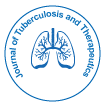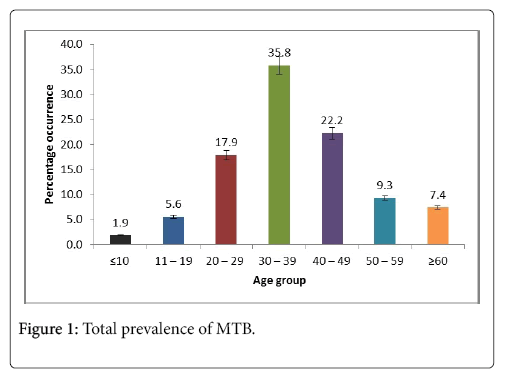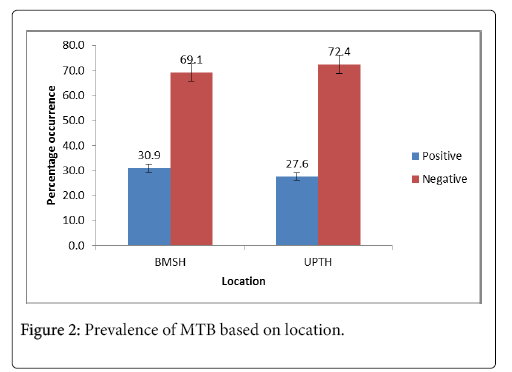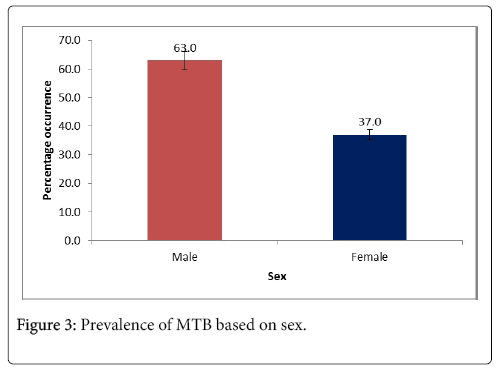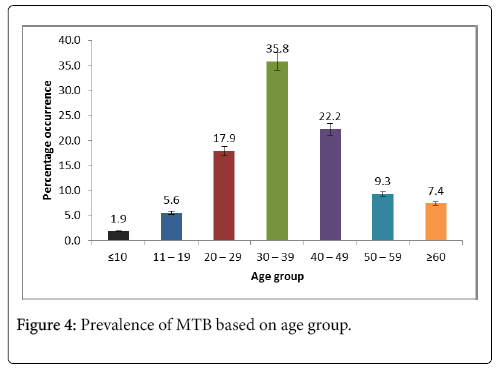Investigation of Prevalence of Tuberculosis Infection Outcome in Two Government Owned Hospitals in Port Harcourt, Niger Delta
Received: 03-Feb-2018 / Accepted Date: 28-Feb-2018 / Published Date: 07-Mar-2018
Abstract
Background: Tuberculosis is a disease caused by the bacterium Mycobacterium tuberculosis and it is easily transmissible by inhalation of air droplets from an infected individual. The presence of tuberculosis has become a public health issue globally, mainly due to its means of transmission and long period of treatment.
Materials and methods: This study was carried out to determine the prevalence of this disease in two public hospitals, which were the Braithwaite Memorial Specialist Hospital (BMSH) and the University of Port Harcourt Teaching Hospital (UPTH), all in Port Harcourt, Rivers State.
Results: The study was carried out on 555 (269 from BMSH and 286 from UPTH) subjects visiting the health facilities and thus, recorded a total prevalence of 29.2% in all. BMSH recorded 30.9% prevalence while UPTH recorded 27.6% prevalence respectively. Patients within the ages 30-39 made up 35.8% of the total prevalence, while those who were less than 10 years old made up 1.9% of the total prevalence. Male subjects made up 63% of the prevalence while females made up 37% of the prevalence.
Conclusion: The BMSH is a state government owned specialist hospital and so this may have accounted for the increased prevalence as most patients believed they will be well attended to speedily when compared with the UPTH which is a federal government owned facility with a lot bottle neck protocols. It is however important that continued surveillance be carried out as well as free or subsidized TB drugs be made available for patients confirmed to be TB positive. Other means of reducing its prevalence could be quarantining patients until the bacterium has been cleared from their system, so as to avoid cross contamination and transmission to healthy persons whether at home, work or on the road, even as reduction of overcrowding in schools, churches, mosques and prisons would certainly help to reduce the burden in our remote settings/villages.
Keywords: Mycobacterium tuberculosis; Infection; Risk factors; Prevalence
Introduction
Tuberculosis (TB) is caused by Mycobacterium tuberculosis. M. tuberculosis belongs to a large group of bacteria referred to as acid-fast bacilli. Another bacterium in this genus is M. leprae which causes leprosy. Detection of its presence is usually done using microscopy or GeneXpert which is a molecular assay and also chest X-ray. Two forms of this disease exists which is Pulmonary Tuberculosis (PTB) and Extra Pulmonary Tuberculosis (EPTB). Source of infection is often through an untreated patient; when the patient coughs, sneezes or spits out tiny droplets which contain tubercules and these are transmitted through inhalation of these droplet nuclei [1]. The bacterium is able to affect virtually every organ of the body but mainly affects the lungs in at least 80% of all TB cases [1]. EPTB however affects organs such as the lungs, bones and joints, meninges and lymph nodes [2]. Symptoms of TB infection include cough (lasting for 3 weeks or more without sputum production, chest pain, haemoptysis (coughing up blood), fever, fatigue, weight loss that cannot be explained and loss of appetite, while the symptoms of EPTB depends on the part of the body being affected but may include blood in urine (TB of kidney), hoarseness (TB of larynx), confusion or headache (TB of meninges) and back pain (TB of spine) [3].
Nonetheless, in many middle and low income nations, TB has been implicated as a major infectious disease [4]. Reports have shown that one-third of the world’s population is asymptomatically infected with Mycobacterium tuberculosis [5]. The Sub-Saharan region of the world of which Nigeria is part is not excluded, as Nigeria with a population of about 150 million has a high TB prevalence. Nevertheless, tuberculosis has been tagged a public health issue in the country as it is ranked 10th among the 22 countries in the world with high TB burden and 4th in Africa, after South Africa, Ethiopia and Democratic Republic of Congo [6]. This increased prevalence of HIV also increases the burden of TB as HIV related TB is estimated to be 25.6% respectively. The North Central geopolitical zone which has a highest HIV prevalence in the country has a corresponding highest TB prevalence [7]. Deaths resulting from TB infection has been said to be 27 per 100,000 of the population which is about 46,000 deaths per year [1].
Interestingly, the National Tuberculosis and Leprosy Control Programme (NTBLCP) were launched in 1991 in response to TB outbreak under the leadership of the Federal Ministry of Health, Nigeria. The Directly Observed Treatment Short-course (DOTS) strategy was adopted in 2003 as part of efforts to reduce TB incidence, although it fully took off in 2003. As of 2009, there were 3,459 DOTS centers with each LGA having at least two centers. It is strongly believed that Acid-Fast Bacilli (AFB) diagnosis had been made easy since 2009 with 1,025 facilities which included laboratories with high - powered microscopes being provided [1]. Nevertheless, it is further opined that one critical reason for its increased prevalence and persistent infection among the vulnerable or susceptible groups have been said to be drug resistance fallout to two main first line drugs, which are rifampicin and isoniazid [5]. However, most of its prevention and control programmes are based on early diagnosis as well as identification of the drug resistant strains outcome [8].
Sadly, despite the implementation of the DOTS strategy across Nigeria states cum regions, TB is still regarded as a potential public health concern in Nigeria with far reaching clinical consequences. Thus, it is therefore very expedient that its prevalence be determined at every point in time, as this will help to evaluate how far the fight against its spread has been achieved over time. Secondly, this will also help in the formulation of government guidelines and policies on TB control and diagnostic strategy in the country. It is strongly believed that the study was aimed at determining the prevalence of TB scourge epidemic in two government owned hospitals in Port Harcourt which is located in Rivers State; one of the richest oil states in the Niger Delta cum Nigeria at large.
Materials and Methods
Study area
The location of this study was Port Harcourt. Subjects were drawn from the Braithwaite Memorial Specialist Hospital (BMSH) and the University of Port Harcourt Teaching Hospital (UPTH) respectively. UPTH is a federal government owned hospital located in East-West Road. The hospital commenced operation in 1980 but it was commissioned in 1985, it is also a tertiary health care teaching and research centre in the State, as well as the oil-rich Niger Delta region. Presently, it has about 500 beds.
BMSH is a state owned hospital located in the old Government Residential Area (GRA) and was named after a British Doctor and pioneer surgeon in Rivers State, Eldred Curwen Braithwaite. It was established in 1925 and named Braithwaite Memorial Hospital and was initially meant for senior civil servants. It boasts of 375 licensed beds and 731 medical staff.
Study population
Inhabitants of this area are mainly civil servants. However, few others engage in oil exploration, trading, farming and fishing activities. The subjects used in this study were those suspected to be having pulmonary TB who was visiting the hospitals within the study period. Subjects were recruited conveniently irrespective of their age and sex; although those were already receiving TB treatment were excluded from this study, even as those who did not consent to be included were also removed. A total of 555 subjects were involved; 271 from BMSH and 285 from the UPTH.
Ethical consideration
Ethical clearance was obtained from the State Ministry of Health and the UPTH ethical committee and then the consent of each patient was also obtained before they were included for this study. All results were handled with utmost confidentiality while those who needed medical attention were referred to laboratory personnel and physicians for further medical attention.
Sample collection
Although other samples such as cerebrospinal fluid, pus, urine or pleural fluid can be used to detect the presence of MTB, sputum is often used if PTB is suspected. However, in this circumstance, the convenient sampling technique were explored and about 2ml of patient’s sputum was collected using sterile sample bottles on the day the patient visited the health facility. Laboratory identification numbers were assigned to each sample and the date of collection and sex of patient was recorded. The collected samples were put in ice packed coolers and transported to the Laboratory immediately for analysis. Procedure for microscopy was done according to the method described by Chesbrough [9]. All collected samples were prepared and stained accordingly as soon as they arrived the laboratory.
Detection of M. tuberculosis by microscopy
Mycobacteria are often referred to as acid-fast bacilli (AFB). This is because they have a waxy coat which retains an aniline dye (e.g. carbol fuchsin) after decolourization with acid-alcohol. This staining process is referred to as Ziehl-Neelsen staining technique.
A smear of the sputum is made on a clean slide, fixed and then carbol fuchsin is used to cover it and left for 3 minutes. It is heated, rinsed with tap water and decolourized with acid-alcohol for 5 seconds. It is then covered with a counterstain (methylene blue) for 30 seconds, rinsed again with tap water and allowed to air dry. The stained smear is then viewed under a microscope using the 100 x oil immersion lens. The bacilli often appear as red beaded rods, 2-4 μm long and 0.2 – 0.5 μm wide. This process was carried out for each sputum sample collected.
Results
This study was carried out on 555 sputum samples collected from the University of Port Harcourt Teaching Hospital (286 samples) and the Braithwaite Memorial Specialist Hospital (269 samples). Nonetheless, the study recorded a total prevalence of 29.2% in all.
BMSH and UPTH recorded a prevalence rate of 30.9% and 27.6% respectively. Males made up 63% while females made up 37% of the total prevalence. The results are represented with charts as shown below for clarity purposes (Figures 1-4).
Discussion
Tuberculosis is a respiratory tract illness and has for a while been regarded as a public health concern owing to its increased prevalence and spread through air droplets. Its treatment is usually done using antibiotics such as rifampicin and isoniazid. However, in recent times, resistance to these drugs has been recorded. It is thus, important that regular surveillance be carried out to determine its prevalence at any point in time especially in endemic areas such as Nigeria with increasing trend of evidence based weak health infrastructure, coupled with expounding indices of risk factors, such as poverty and poor personal hygiene outcome, that favors the spread of the scourge in our remote communities.
This study which was carried out on TB from the Braithwaite Memorial Specialist Hospital (BMSH) and the University of Port Harcourt Teaching Hospital (UPTH) recorded a prevalence rate of 29.2% from a sample size of 555 in overall. This is close to that recorded by Nwachukwu and Peter (21.6%) in Abia State, Nigeria [10], but higher than that recorded by Azuonwu et al. in their study carried out in Bayelsa State, Nigeria where they recorded a prevalence of 10.3% [11]. This difference in prevalence may be attributed to the increased sample in this study and also the fact that Port Harcourt is densely populated when compared to Yenagoa side by side where the previous study was carried out.
Males and females made up 63% and 37% of the total prevalence respectively. This gender difference was also reported by Jumbo et al. in their study carried out between 2003 and 2012 at a DOTS centre at Igbogene, Yenagoa [4]. They observed that males accounted for 61.4% of the total prevalence while females accounted for 38.6% within the same period. Similar studies by Okonko et al. [12] Obiora et al. [13] and Akpaka et al. [14] also recorded a higher prevalence among males. Nwachukwu and Peter also recorded a higher TB infection rate among males [10]. The study by Azuonwu et al. however was not in agreement with this study as females made up a higher percentage (55.7%) of the total prevalence than males [11]. Although the reason for this difference was not investigated, Diwan et al. suggested that immunological and biological differences may be responsible for men being infected with TB more than their female counterparts [15]. Another explanation that could probably be linked to this scenario is that men are more often having a broader and functioning open social network than females which expose them to the pathogenic infection [4]. Also, women are more likely to seek for medical help than males [16]. As men are often seen as risk takers hence would not want to speak out for so long or visit health facility for possible early diagnosis and treatment.
Nevertheless, ages of 30-39 made up 35.8% of the total prevalence (the highest) while patients less than 10 made up 1.9% of the total prevalence. This is almost similar to the result reported by Azuonwu et al. who recorded a higher among ages 20-39 compared with other age classes [11]. Another study carried out by Nwachukwu and Peter also recorded a higher prevalence among persons within ages 26-35 [10]. The low standard of living of the people which may have made it difficult to feed well so as to resist infections may have contributed to this increased prevalence. Unimplemented or irregular government policies as well as ineffective health care delivery system may have also contributed to this increased prevalence rate among the age brackets [17,18].
It should be noted that most persons with symptoms of TB such as chest or recurring coughing may not want to visit the health care facility for diagnosis but rather, would resort to visiting patent medicine stores where antibiotics may be given to them without accurate evidence based diagnostic and treatment strategy from a trained health personal. This may not cure the TB infection, but may further increase cases of antibiotic resistance saga, which is also a critical public health issue with grievous health consequences. Some may choose to take traditional herbal medicines, while others resort to visiting religious houses when it becomes severe. On the other hand, most sick persons would rather not know the name or cause of their illness as they are already believed that the cause of their illness could not have originated from medical point of view, rather ancestral origin. However, those with latent TB (asymptomatic) may look healthy and so when asked to visit the health facility for medical checkup will always feel reluctant and would not accept the offer, because they have continued to feel within them, that they are healthy as far as they are concerned without much palpable signs and symptoms.
Conclusion
This study was carried out on subjects and samples were collected from two prominent hospitals in Port Harcourt, Nigeria recorded a 29.2% prevalence rate. The hospitals were the Braithwaite Memorial Specialist Hospital and the University of Port Harcourt Teaching Hospital. Males and patients within ages 30-39 recorded the highest prevalence based on sex and age respectively. Reasons for this increased prevalence have been said to be overcrowding in markets and homes, refusal to visit the health facility for early diagnosis, rifampicin resistance, poverty and the fear of death.
It is therefore, strongly suggested that public awareness on latent TB be carried out as this is evidently a silent killer. The public should be encouraged to visit health facilities for regular checkups as well as avoid taking drugs without physician’s prescription. Confirmed TB patients should be encouraged to complete their medication as well as return back for diagnosis to confirm that the bacterium has been cleared from their system. Persons living with TB patients should avoid sharing of cups and other utensils that can come in contact with their mouth or nostrils. Where possible, provision of housing at subsidized rate should be provided to prevent overcrowding as overcrowding can encourage the spread of most respiratory illnesses which includes TB. Further studies should be carried out to elucidate very clearly and succinctly the reasons for increased TB infection among males compared with their female counterparts as reported by this study. More collective effective efforts should be mobilized by potential stakeholders to reduce the risk factors, especially the risk of HIV infection should be tackled head-long as the correlation of HIV/AIDS with the TB co-infection has remained a source of public health concerns across the endemic regions of both scourge. Further study involving 2 or more sputa collected from a patient can be done to compare the result with that of single sputum from a patient used in determining the presence of MTB.
References
- Ghosh S (1983) Primary health care for developing countries.Indian Pediatr 20: 235-242.
- American Thoracic Society (2000) Diagnostic standards and classification of tuberculosis in adults and children. Am J RespirCrit Care Med 161: 1376–1395.
- Jumbo J, Obaseki DO, Ikuabe PO (2013) Tuberculosis and gender parity in a TB Referral Centre, South –South Nigeria. Greener JMed Sci 3: 270-275.
- World Health Organization (2013) The use of bedaquiline in the treatment of multidrug-resistant tuberculosis: Interim Policy Guidance. WHO, Geneva, Switzerland.
- World Health Organization (2012) Report of First National TB Prevalence Survey. Federal Republic of Nigeria.
- National Tuberculosis and Leprosy Control Programme(2014) Towards Universal Access to Prevention, Diagnosis and Treatment. The National Strategic Plan for Tuberculosis Control.
- World Health Organization (2009) Non-commercial culture and drug susceptibility testing for rapid screening of patients at risk of MDR-TB. WHO, Geneva, Switzerland.
- Cheesbrough M (2006) District laboratory practice in tropical countries. Part 2. Cambridge University Press, US.pp: 39-40.
- Nwachukwu E, Peter GA (2010) Prevalence of Mycobacterium tuberculosis and human immunodeficiency virus (HIV) infections in Umuahia, Abia state, Nigeria. Afri J Micro Res 4: 1486-1490.
- Azuonwu O, Ihua N, Koomasiruchi W (2017) Molecular detection of Mycobacterium tuberculosis (MTB) and rifampicin resistant strain among subjects accessing health care at federal medical centre, Yenegoa, Bayelsa State; Nigeria. Transl Biomed 8: 120.
- Okonko IO, Soleye FA, Adeniji FO, Okerentugba PO (2012) HIV and TB co-infection among patients on directly observed treatment of short course in Abeokuta, Ogun State, Nigeria. Nature and Science 10: 10-14.
- Nwobu GO, Okodua MA, Tatfeng YM (2004) Comparative study of HIV associated pulmonary tuberculosis in chest clinics from two regions of Edo state, Nigeria. Online J Health Allied Scs 3: 4.
- Akpaka PE, Tulloch-Reid M, Justiz-Vaillant A, Smikle MF (2006) Prevalence of human immunodeficiency virus infection in patients with pulmonary tuberculosis at the National Chest Hospital in Jamaica. Rev Panam Salud Publication 19:38–43.
- Diwan VK, Thorson A (1999) Sex and gender and tuberculosis. Lancet 353: 1000-1001.
- Thorson A, Hoa NP, Long NH (2000) Health-seeking behaviour of individuals with a cough for more than 3 weeks. Lancet 356: 1823-24.
- Azuonwu O, Nnenna I, Uwuma OE (2017) Evaluation of haematological profile of geriatric subjects in port Harcourt metropolis of Niger Delta of Nigeria. J Clin Lab Med 2: 111.
- Azuonwu O, Nnenna I, Douglass AS, Ntaa NB (2016) Consequences of haemolytic disease of the fetus and newborn (HDFN) and the clinical significance of antibody screening in prenatal diagnosis: A study of multigravidal and primigravidal women in Port Harcourt, Niger Delta. J Clin Lab Med 1: 1 06.
Citation: Obioma A, Ngozika WG (2018) Investigation of Prevalence of Tuberculosis Infection Outcome in Two Government Owned Hospitals in Port Harcourt, Niger Delta. J Tuberc Ther 3: 114.
Copyright: © 2018 Obioma A, et al. This is an open-access article distributed under the terms of the Creative Commons Attribution License, which permits unrestricted use, distribution, and reproduction in any medium, provided the original author and source are credited.
Select your language of interest to view the total content in your interested language
Share This Article
Open Access Journals
Article Usage
- Total views: 6212
- [From(publication date): 0-2018 - Dec 08, 2025]
- Breakdown by view type
- HTML page views: 5231
- PDF downloads: 981
